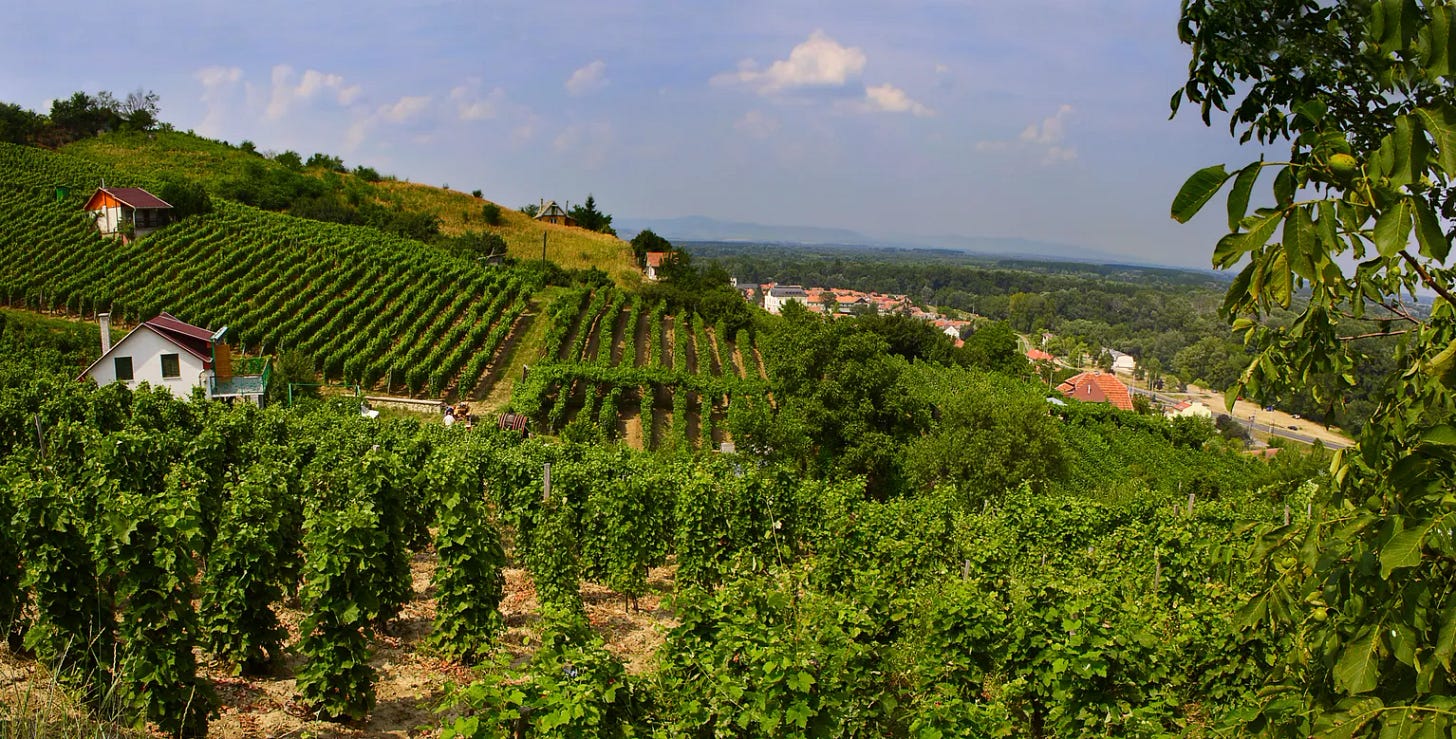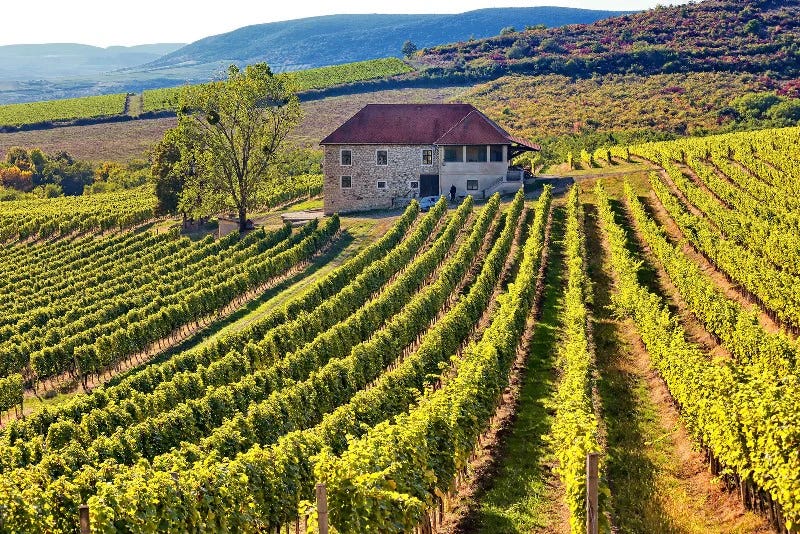Hungary is a landlocked country in Central Europe, and boasts a rich and storied tradition of viticulture that dates back over a thousand years. With a winemaking history that stretches to the Roman era, Hungary has long been recognized as one of Europe's premier wine-producing nations.
Its strategic location along the Danube River and the Carpathian Basin has endowed it with fertile soils and diverse microclimates, making the country an ideal environment for cultivating a variety of grape types. Hungarian wine is deeply interwoven with the country’s history, shaped by both agricultural innovation and political developments over the centuries.
Agriculture has always played a central role in Hungary’s economy and cultural identity, with winemaking occupying a significant place within that tradition. The country’s viticultural success can be attributed to its diverse landscapes, which include the volcanic soils of the Tokaj region, the limestone-rich terroirs of Villány, and the cool-climate vineyards of Eger. Each region contributes to the complexity and distinctiveness of Hungary’s wine portfolio, with everything from robust reds to delicate whites and world-famous sweet wines like Tokaji Aszú.
Historically, Hungary’s wine industry has been influenced by its political fortunes. The country’s Christianization in the 10th century under King Stephen I fostered the expansion of vineyards as the nobility began to support viticulture. During the Ottoman occupation from the 16th to the 18th centuries, certain wine regions, such as Tokaj, thrived as Hungarian wines became coveted exports. In fact, Tokaji Aszú, known as the "Wine of Kings and King of Wines," gained international recognition and was favored by European royal courts.
However, the political upheavals of the 20th century, including the impact of both World Wars and the subsequent Soviet influence, deeply affected the wine industry. Under Communist rule, Hungarian wine production was centralized and focused on quantity over quality, leading to a decline in the global reputation of Hungarian wines. It was not until the fall of the Iron Curtain in 1989 and the country’s transition to democracy that Hungary’s wine industry began to recover. In the decades that followed, winemakers returned to traditional methods, reinvested in quality viticulture, and embraced modern techniques, resulting in a resurgence of Hungarian wines on the international stage.
This dynamic nation is experiencing a renaissance in winemaking, with a renewed focus on quality, sustainability, and regional distinctiveness. This revival has been supported by the country's membership in the European Union, which has provided Hungarian winemakers access to new markets and resources. As Hungary continues to navigate the complexities of its political and economic landscape, the nation’s wine industry remains a point of pride, embodying both its agricultural heritage and its potential for future innovation.
Geographic Influences on Hungarian Wine
Hungary’s geographical diversity plays a pivotal role in shaping the quality and character of its wines. The country’s unique landscape, marked by the Danube River, the influence of the Alps, and the vast Pannonian Plain, creates an array of microclimates and soil types that make Hungary a highly diverse wine-producing region. These geographical factors not only contribute to the distinctiveness of Hungary’s wines but also provide ideal growing conditions for a wide variety of grape types, from robust reds to crisp whites and sweet dessert wines.
The Danube River, which traverses the heart of Hungary, is one of the country’s most significant natural features. The river acts as a moderating influence on the climate, tempering the extremes of temperature and providing essential water resources for agriculture. Many of Hungary’s prime vineyards are located in the vicinity of the Danube, benefitting from the river’s impact on soil composition and the local climate. The river's fertile valleys, particularly in regions like Etyek-Buda and Szekszárd, offer excellent conditions for viticulture, fostering the growth of high-quality grape varieties. The Danube also serves as a crucial transportation route, historically facilitating the movement of wine across Europe and contributing to Hungary’s rich trade history.
In addition to the Danube, the Alps exert a significant influence on Hungary’s wine regions, particularly in the northwestern parts of the country. Though the Alps are located outside of Hungary’s borders, their proximity helps to create cool, continental climatic conditions in regions like Sopron and Eger. The cooler temperatures, combined with hillside vineyards, provide an ideal environment for the cultivation of varietals like Kékfrankos and Pinot Noir. These regions benefit from the cooling winds that descend from the mountains, which help to preserve acidity and balance in the wines, leading to elegant, structured reds with aging potential.
Perhaps the most defining geographical feature of Hungary is the Pannonian Plain, a vast lowland that covers much of the central and eastern parts of the country. This plain, with its rich loamy soils and sunny, warm climate, is highly conducive to agriculture and viticulture. The regions within the Pannonian Plain, such as Kunság and Csongrád, are known for producing more accessible, everyday wines that thrive in the warmer climate. The plain’s expansive vineyards yield both indigenous and international grape varieties, offering wines that range from aromatic whites to bold reds. The Pannonian Plain is a critical agricultural hub, providing the volume of production that balances Hungary’s more specialized, high-quality wine regions.
Together, the Danube, the influence of the Alps, and the vast Pannonian Plain create a rich tapestry of terroirs that contribute to the diversity and excellence of Hungarian wine. These geographical features not only define the country’s viticultural landscape but also enhance the complexity and regional identity of the wines, positioning Hungary as one of Europe’s most geographically blessed wine producers.
Impactful Wine Regions and Grape Varieties
Hungary’s wine industry is renowned for its regional diversity, which produces a wide range of wine styles from sweet to dry, and from white to red. Among the country’s most significant regions is Tokaj, globally recognized for its production of Tokaji Aszú, one of the world’s finest sweet wines. This region, located in northeastern Hungary, has become synonymous with high-quality dessert wines, earning the prestigious designation of a UNESCO World Heritage Site. Tokaji Aszú, made primarily from the Furmint grape, is celebrated for its balance of sweetness and acidity, achieved through the process of noble rot (Botrytis cinerea), which concentrates the sugars in the grapes. The result is a rich, complex wine with flavors of apricot, honey, and spice, known for its remarkable aging potential. Tokaji remains Hungary’s most famous export and continues to represent the pinnacle of the country’s winemaking tradition.
In recent years, dry Furmint has emerged as another standout wine from the Tokaj region. While traditionally used in sweet wines, Furmint’s potential for dry expressions has garnered increasing attention on the international stage. These wines are highly regarded for their minerality, crisp acidity, and elegance, offering vibrant flavors of green apple, citrus, and herbs. The versatility of Furmint allows it to thrive in both sweet and dry styles, making it one of Hungary’s most important and distinctive grape varieties.
“Hungary has all of the tools and talent of any great wine region, with centuries of experience navigating the agricultural and cultural challenges of central Europe.”
Beyond Tokaj, Hungary produces exceptional red wines, particularly from the regions of Villány, Szekszárd, and Eger. Villány, located in the country’s southernmost wine region, is known for its full-bodied red blends, primarily featuring international varieties like Cabernet Sauvignon, Merlot, and Syrah, alongside indigenous grapes such as Kékfrankos and Kadarka. These blends often exhibit rich, dark fruit flavors, firm tannins, and a smooth texture, showcasing the region’s warm climate and limestone-rich soils. Szekszárd, another prominent red wine region, is noted for its spicy and structured reds, with Kékfrankos playing a central role in the production of both single-varietal wines and blends. Szekszárd’s wines are often characterized by their elegance and complexity, balancing fruit, spice, and earthiness.
Eger, located in northern Hungary, is famous for its "Egri Bikavér" (Bull's Blood), a traditional red blend that dates back centuries. This blend typically includes a combination of Kékfrankos, Kadarka, and several international varieties, resulting in a wine that is rich in flavor and steeped in historical significance. Egri Bikavér is one of Hungary’s most exported red wines, with its robust character and deep red hue making it a popular choice in both domestic and international markets.
Hungary’s portfolio of grape varieties is equally diverse. Alongside Furmint, grapes like Hárslevelű, Olaszrizling, and Juhfark are integral to the production of high-quality white wines. These varietals contribute to Hungary’s reputation for producing aromatic and textured whites, many of which are well-suited to aging. Kékfrankos, often referred to as Blaufränkisch in Austria, is Hungary’s most widely planted red grape variety and serves as the backbone of many of the country’s red blends, prized for its versatility and capacity to produce wines ranging from light and fruity to bold and age-worthy.
On the global stage, Hungary’s most notable wine exports include Tokaji Aszú, dry Furmint, and Egri Bikavér. These wines have played a key role in reestablishing Hungary as a major player in the international wine market, attracting attention for their quality, history, and unique regional expressions. The country’s commitment to both preserving traditional methods and embracing innovation continues to drive the global appeal of Hungarian wines, positioning them as a significant force in the world of fine wine.
The Confluence of History, Geography, and Expertise
Hungary’s wine industry stands at the intersection of a rich historical legacy, diverse geography, and centuries of winemaking expertise. The country’s long tradition of viticulture, dating back to the Roman era, has been shaped by political shifts and agricultural advancements that continue to influence its wine production today. Hungary’s varied geography, from the fertile valleys of the Danube to the cooling influence of the Alps and the expansiveness of the Pannonian Plain, provides an ideal environment for cultivating a broad range of grape varieties. This diversity is reflected in Hungary’s wide array of wines, from the world-renowned sweet Tokaji Aszú to innovative dry Furmints and robust red blends.
As Hungary embraces the future, its wine industry is poised for even greater success. The combination of centuries-old traditions and modern winemaking techniques ensures that Hungarian wines remain both distinctive and competitive on the global stage. With an increasing focus on quality, sustainability, and regional authenticity, Hungary is well-positioned to continue its rise as a major player in the international wine world. The confluence of its rich history, diverse geography, and the dedication of its winemakers guarantees that Hungary’s wines will not only honor their storied past but also lead the country into a bright and prosperous future.

















Share this post